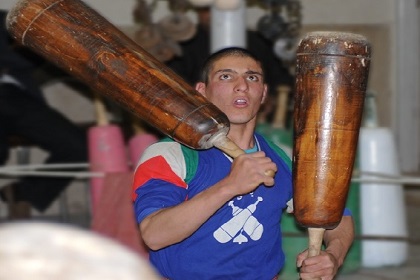Varzesh-e Pahlavani, known as Varzesh-e Bastani, was originally an academy of physical training and a nursery for warriors against foreign invaders similar in purpose to martial arts. Throughout the last 3000 years it acquired different components of moral, philosophical, and mystical values of the Iranian civilization. As a result, Varzesh-e-Pahlavani incorporated the richness of Sufism, rituals of Mithraism, and the heroism of Iranian nationalism. Many of these Pahlavans (sport heroes) were responsible for revolting against invaders throughout the history of Iran. Yet the word Pahlavan has been misused, either by the scholars, unqualified writers or by the masses who did not have access to accurate sources. Varzesh-e Pahlavani can be traced back to the Parthian Empire of Iran (132 BC – 226 AD). The word Pahlavan comes from Parthia. There are similarities between rituals of Mithraism and Varzesh-e Pahlavani. Mithraic temples are similar in structure to Zurkhanes, the place where the rituals of Varzesh-e Pahlavani are practiced. After the invasion of Western values into Iran in the early 1900’s and the poorly designed policies, of the Pahlavi regime, Varzesh-e Pahlavani lost its popularity. Many heroes of Varzesh-e Pahlavani such as Pahlavan-e Bozorg and Haj Seyyed Hasan Razaz (~1853-1941), In famous poet Ferdowsi’s epic work, the Shahnameh, the Book of Kings, mythical Pahlavans fight against the evil forces. Often, the result of a war was determined in a hand-to-hand combat, called Koshti (wrestling). The legendary Pahlavan of this era is Rostam who was always saving. During the Islamic period in what is now Iran (from 650 on), the school of Pahlavani was an academy of physical training. However, with introduction of Islam and Shi’sm some four hundred years later during the Safavid Dynasty, new dimensions were added to Varzesh-e Pahlavani: philosophy and spirituality of Islam. Sufism was the medium for the expression of these dimensions. Some of the most famous Pahlavans of all time appeared between 1800 and today: Pahlavan-e Bozorg Razaz, Pahlavan Boloorforoush, Pahlavan Toosi and Jahan Pahlavan Takhti. The peak of Varzesh-e Pahlavani was during the reign of Naser-e-din Shah (1848-1896).At that time, many Zurkanes were built throughout the country. An official Pahlavan was determined each year (on the first day of the Iranian new year) in a competition conducted in front of the Shah.



Comment (0)